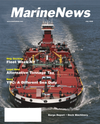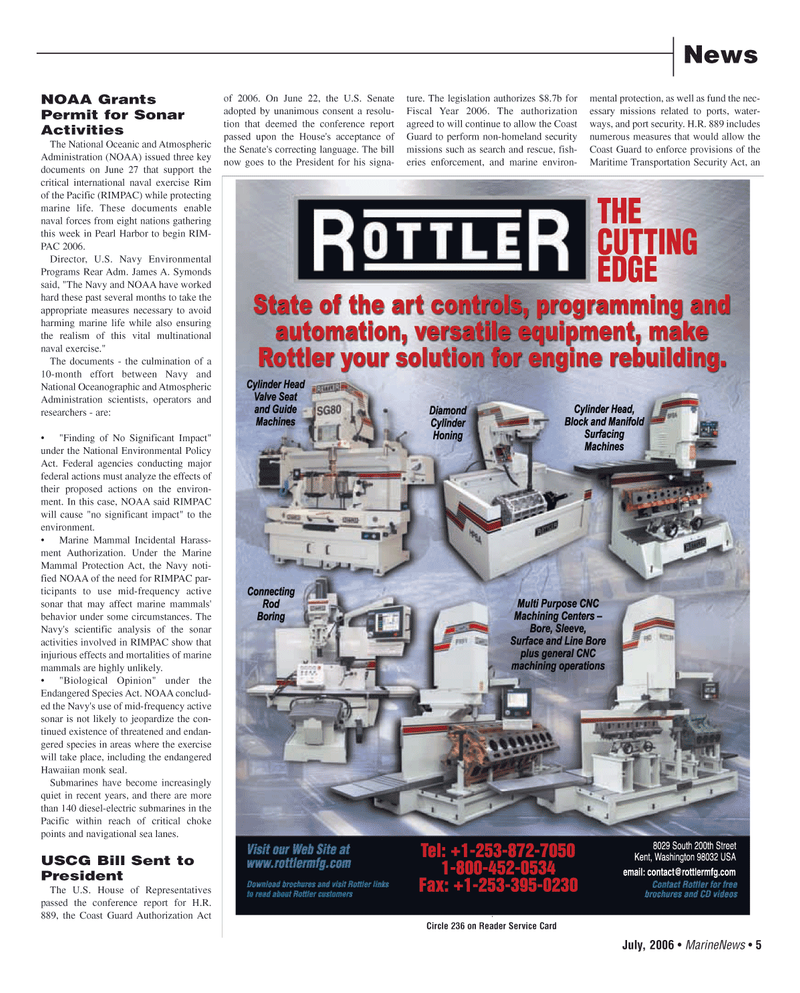
Page 5: of Maritime Reporter Magazine (July 2006)
The Satellite Communication Edition
Read this page in Pdf, Flash or Html5 edition of July 2006 Maritime Reporter Magazine
July, 2006 • MarineNews 5
News
NOAA Grants
Permit for Sonar
Activities
The National Oceanic and Atmospheric
Administration (NOAA) issued three key documents on June 27 that support the critical international naval exercise Rim of the Pacific (RIMPAC) while protecting marine life. These documents enable naval forces from eight nations gathering this week in Pearl Harbor to begin RIM-
PAC 2006.
Director, U.S. Navy Environmental
Programs Rear Adm. James A. Symonds said, "The Navy and NOAA have worked hard these past several months to take the appropriate measures necessary to avoid harming marine life while also ensuring the realism of this vital multinational naval exercise."
The documents - the culmination of a 10-month effort between Navy and
National Oceanographic and Atmospheric
Administration scientists, operators and researchers - are: • "Finding of No Significant Impact" under the National Environmental Policy
Act. Federal agencies conducting major federal actions must analyze the effects of their proposed actions on the environ- ment. In this case, NOAA said RIMPAC will cause "no significant impact" to the environment. Marine Mammal Incidental Harass- ment Authorization. Under the Marine
Mammal Protection Act, the Navy noti- fied NOAA of the need for RIMPAC par- ticipants to use mid-frequency active sonar that may affect marine mammals' behavior under some circumstances. The
Navy's scientific analysis of the sonar activities involved in RIMPAC show that injurious effects and mortalities of marine mammals are highly unlikely. "Biological Opinion" under the
Endangered Species Act. NOAA conclud- ed the Navy's use of mid-frequency active sonar is not likely to jeopardize the con- tinued existence of threatened and endan- gered species in areas where the exercise will take place, including the endangered
Hawaiian monk seal.
Submarines have become increasingly quiet in recent years, and there are more than 140 diesel-electric submarines in the
Pacific within reach of critical choke points and navigational sea lanes.
USCG Bill Sent to
President
The U.S. House of Representatives passed the conference report for H.R. 889, the Coast Guard Authorization Act of 2006. On June 22, the U.S. Senate adopted by unanimous consent a resolu- tion that deemed the conference report passed upon the House's acceptance of the Senate's correcting language. The bill now goes to the President for his signa- ture. The legislation authorizes $8.7b for
Fiscal Year 2006. The authorization agreed to will continue to allow the Coast
Guard to perform non-homeland security missions such as search and rescue, fish- eries enforcement, and marine environ- mental protection, as well as fund the nec- essary missions related to ports, water- ways, and port security. H.R. 889 includes numerous measures that would allow the
Coast Guard to enforce provisions of the
Maritime Transportation Security Act, an
Circle 236 on Reader Service Card
JULY MN2006 1(1-8).qxd 7/6/2006 4:06 PM Page 5

 4
4

 6
6
